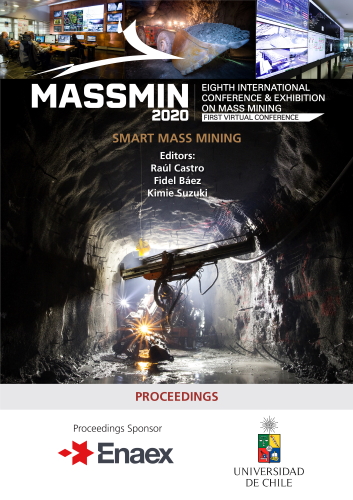Block cave ore reserves: Are we reporting a reserve or potential inventory?

|
Authors: Burgio, N |
This paper is hosted with the kind permission of Lulea University of Technology, International Conference & Exhibition on Mass Mining, 2024.
DOI https://doi.org/10.36487/ACG_repo/2063_75
Cite As:
Burgio, N 2020, 'Block cave ore reserves: Are we reporting a reserve or potential inventory?', in R Castro, F Báez & K Suzuki (eds), MassMin 2020: Proceedings of the Eighth International Conference & Exhibition on Mass Mining, University of Chile, Santiago, pp. 1039-1047, https://doi.org/10.36487/ACG_repo/2063_75
Abstract:
Over the past 20 years, block cave operations have pushed the technical frontiers of caving mechanics by mining stronger rock masses, going deeper, extracting taller cave columns and demanding higher productivity rates. The methods and practices for the reporting of block cave ore reserves may not adequately allow for technical uncertainties in these complex and geotechnically challenging conditions. The actual performance of caving operations can vary significantly due to various technical, mining and economic factors. The ability to generate an ore reserves which is convincing has its challenges, particularly at conceptual and pre-feasibility levels when orebody access is generally unavailable to confirm the geotechnical environment that supports the parameters and assumptions that underpin block cave reserves. This paper considers whether current practices meet the guidelines required by industry reporting Codes, and why some operations struggle to meet initial reserve forecasts. Some ideas are offered in how technical risks can be better incorporated into establishing a credible base case scenario.
References:
AusIMM, AIG & MCA 2012, ‘Australian Code for Reporting of Exploration Results, Mineral Resources and Ore Reserves’, Joint Ore Reserves Committee of the Australian Institute of Mining and Metallurgy, Australian Institute of Geoscientists and Minerals Council of Australia (JORC).
Beck, D 2019, Simulation of Potential Subsidence, internal report, Serengeti Resources, Vancouver.
Brunton, I, Lett, JL, Sharrock,GB, Thornhill, T & Mobolio, B 2016, ‘Full-scale Flo marker Experiments at the Ridgeway Deeps and Cadia East Cave Operations’, in C Carr & G Chitombo (eds), Proceedings of MassMin 2016, The Australian Institute of Mining and Metallurgy, Sydney, pp. 141-159.
Burgio, N & Diering, T 2008 'Simulating irregular cave propagation using PCBC' Proceedings of Massmin 2008, Luea University of Technology, Lulea, pp. 1033-1042.
Diering, T Ngidi,S, Bezuidenhout,J, & Paetzold, H 2018 ‘ Palabora Lift 1 block cave: understanding the grade behaviour’, Caving 2018 Proceedings of the Fourth International Symposium on Block and Sublevel Caving, pp. 91-106, Vancouver, Canada.
Diering, T 2007, ‘Template mixing: A depletion engine for block cave scheduling’ in EJ Magri (ed.), Proceedings of the 33rd International Symposium on Application of Computers and Operations Research in the Mineral Industry, pp. 313-320, Gecamin, Santiago.
Herbert,Y & Sharrock,G 2018 ‘ Three-dimensional simulation of cave initiation, propagation and surface subsidence using coupled finite difference-cellular automata solution’, Caving 2018 Proceedings of the Fourth International Symposium on Block and Sublevel Caving, pp. 151-166, Vancouver, Canada.
JORC Code 2012, Australian Code for Reporting of Exploration Results, Mineral Resources and Ore Reserves.
Lett, JL, Brunton, I, Capes, GW, Jäger, A, Mobilio, B, Rachocki, J, Sharrock, GB & Secheny, M 2016, ‘Undercutting to surface breakthrough – Cadia East Panel S. Talu, Rio Tinto, Australia.
Lett, JL & Capes, GW 2012, Characterisation of Caving and Subsidence for operational enhancements at the Newcrest Ridgeway Gold Mine, Proceedings of Massmin 2012, Canadian Institute of Mining, Metallurgy and Petroleum, Westmount.
Parsons, J, Hamilton, D 2018, ‘Non-vertical cave and dilution modelling at New Gold’s New Afton Mine’, Caving 2018 Proceedings of the Fourth International Symposium on Block and Sublevel Caving, pp. 323-334, Vancouver, Canada.
Talu, S, Van As, A, Seloka, W & Henry, R 2010, ‘Lift 2 North extension cave performance’, Caving 2010 Second International Symposium on Block and Sublevel Caving, Australian Centre for Geomechanics, Rio Tinto, Australia.
Van As, A., Seloka, W. & Henry,H. 2010, ‘ Lift 2 North extension cave performance’, Caving 2010 Second International Symposium on Block and Sublevel Caving, Australian Centre for Geomechanics Cave, Proceedings of MassMin 2016, The Australasian Institute of Mining and Metallurgy, Melbourne, pp. 65–82.
Van As, A & Van Hout, G, J 2008 'Implications for widely spaced drawpoints’, Proceedings of Massmin 2008, Lulea University of Technology, Lulea, pp. 147-154.
© Copyright 2025, Australian Centre for Geomechanics (ACG), The University of Western Australia. All rights reserved.
View copyright/legal information
Please direct any queries or error reports to repository-acg@uwa.edu.au
View copyright/legal information
Please direct any queries or error reports to repository-acg@uwa.edu.au
